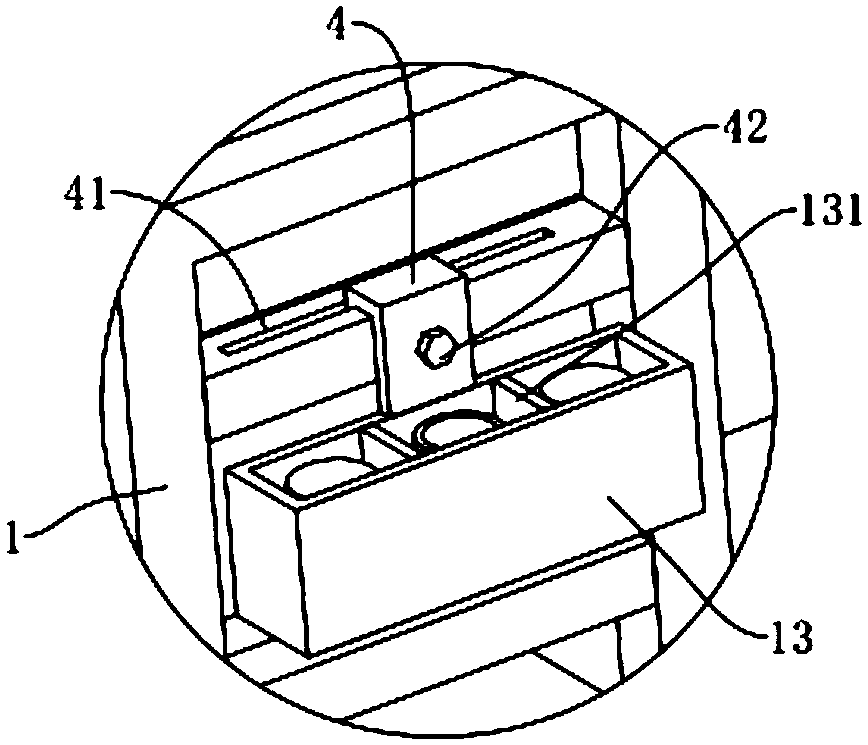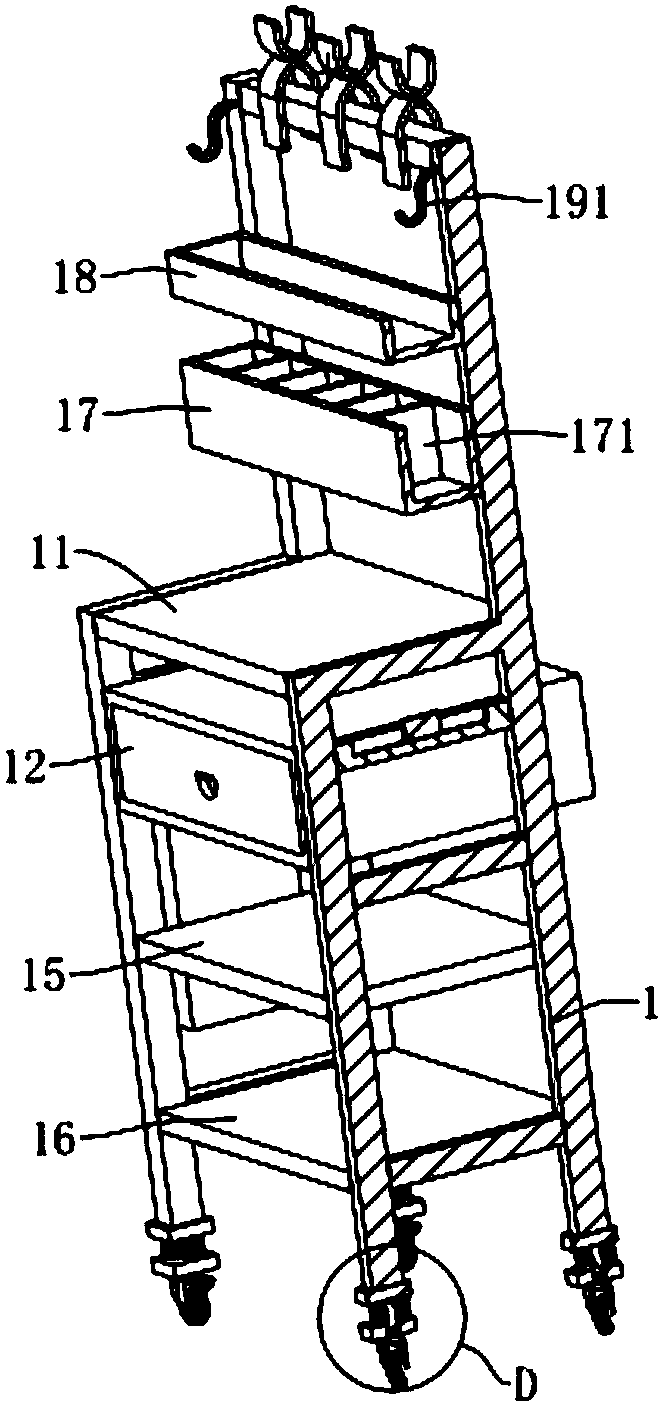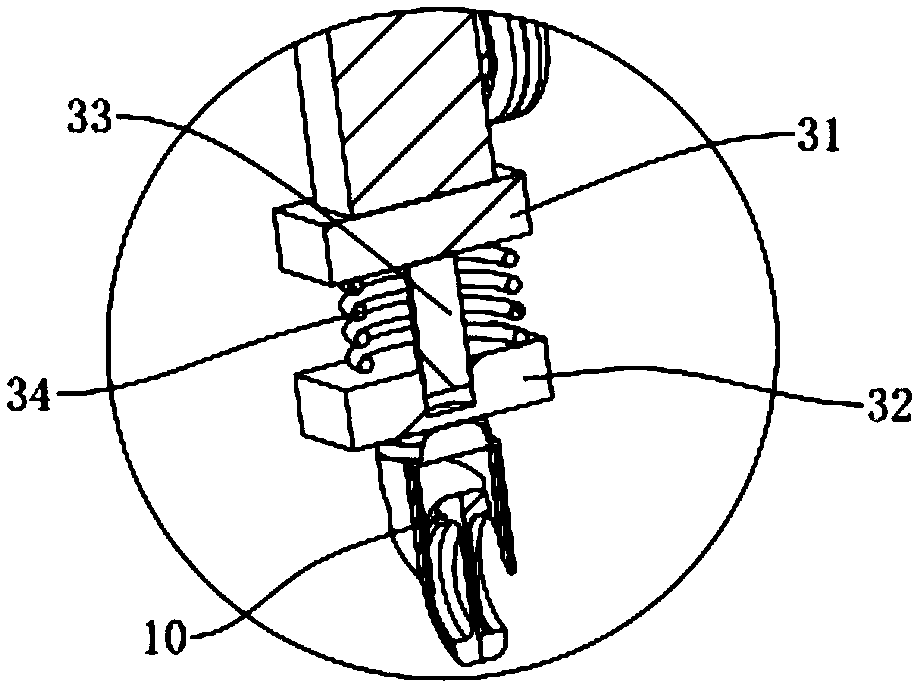Treatment cart
A technology of trolleys and treatment platforms, applied in the field of medical trolleys, can solve problems such as pollution of medicines and tools, inability to conveniently dispense medicines, dispense medicines, store medicines, and inconvenient use of trolleys.
- Summary
- Abstract
- Description
- Claims
- Application Information
AI Technical Summary
Problems solved by technology
Method used
Image
Examples
Embodiment 1
[0055] like Figure 1 to Figure 11 As shown, a treatment trolley includes a trolley body 1, wherein a treatment platform 11 for placing aseptic trays is fixed on the trolley body 1, and only aseptic trays are placed on the treatment platform 11, which can avoid contamination of the sterile trays; And the trolley body 1 is also provided with a drawer 12 below the treatment platform 11, and the drawer 12 is plugged on the trolley body 1. In order to realize the function that multiple medicines can be placed separately inside the drawer 12, two pieces of the first medicine are fixed in the drawer 12. A dividing plate 121 is also slidably connected with a second dividing plate 122 in the drawer 12, wherein on the second dividing plate 122, there are grooves 1220 for passing through the two first dividing plates 121; The side of 1 is also hung with the first hanging basket 13, in order to separately separate the articles hung in the first hanging basket 13, two third partition boar...
Embodiment 2
[0067] The difference from Example 1 is the preparation of the antifouling coating on the surface of the drawer 12, and its preparation method is as follows:
[0068] Take the following components by weight for subsequent use: 38 parts of ethyl acrylate, 26 parts of acrylate, 22 parts of methyl acrylate, 6 parts of ethanol, 5 parts of polyvinyl alcohol, 5 parts of methyl isobutyl ketone, two 5 parts of butylamine, 5 parts of ethyl acetate, 15 parts of deionized water, catalyst: 1 part of dibutyltin dilaurate;
[0069] S1. Preparation of coating water dispersion precursor: Add ethyl crotonate, acrylate, methyl acrylate, polyvinyl alcohol, methyl isobutyl ketone, dibutylamine, and deionized water into a beaker, and use a glass Rod mixing and stirring evenly to obtain the coating water dispersion precursor;
[0070] S2. Heating the water-dispersed precursor of the coating: after adding the water-dispersed precursor of the coating to the round-bottomed flask, fix the round-bottom...
Embodiment 3
[0076] The difference from Example 1 is the preparation of the antifouling coating on the surface of the drawer 12, and its preparation method is as follows:
[0077] Take the following components by weight for subsequent use: 34 parts of ethyl acrylate, 28 parts of acrylate, 24 parts of methyl acrylate, 6 parts of ethanol, 5 parts of polyvinyl alcohol, 5 parts of methyl isobutyl ketone, two 5 parts of butylamine, 4 parts of ethyl acetate, 15 parts of deionized water, catalyst: 1 part of triethylenediamine;
[0078] S1. Preparation of coating water dispersion precursor: Add ethyl crotonate, acrylate, methyl acrylate, polyvinyl alcohol, methyl isobutyl ketone, dibutylamine, and deionized water into a beaker, and use a glass Rod mixing and stirring evenly to obtain the coating water dispersion precursor;
[0079] S2. Heating the water-dispersed precursor of the coating: after adding the water-dispersed precursor of the coating to the round-bottomed flask, fix the round-bottomed...
PUM
 Login to View More
Login to View More Abstract
Description
Claims
Application Information
 Login to View More
Login to View More - R&D
- Intellectual Property
- Life Sciences
- Materials
- Tech Scout
- Unparalleled Data Quality
- Higher Quality Content
- 60% Fewer Hallucinations
Browse by: Latest US Patents, China's latest patents, Technical Efficacy Thesaurus, Application Domain, Technology Topic, Popular Technical Reports.
© 2025 PatSnap. All rights reserved.Legal|Privacy policy|Modern Slavery Act Transparency Statement|Sitemap|About US| Contact US: help@patsnap.com



